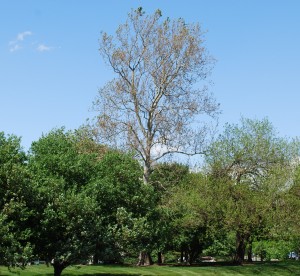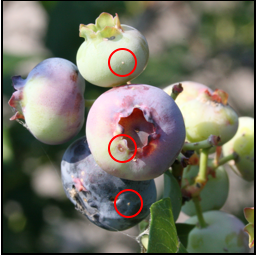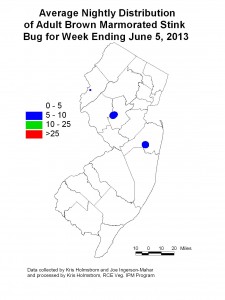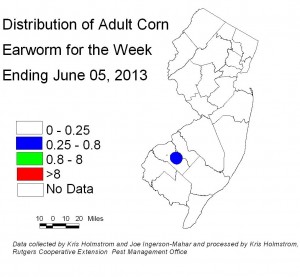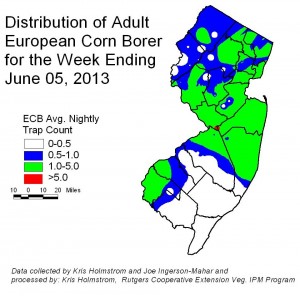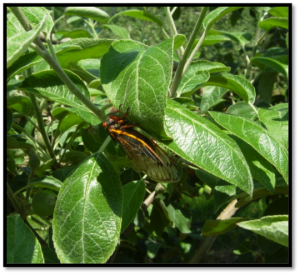Have you noticed in the landscape that the sycamores, and to a lesser degree, the plane trees are devoid of leaves? Anthracnose of Platanus species is a well known disease in our area. The disease causes leaf and shoot blight, twig cankers, and branch dieback, and has been particularly severe this spring.
Archives for June 2013
Blueberry Pest in Detail: Putnam Scale
Tape traps monitored on Tuesday, June 4 showed the start of crawler activity in the Hammonton area.
Life History
Scales feed on plant sap, decreasing plant vigor and fruit yield. Adult scales are protected from insecticide sprays by a waxy covering. These insects are common in older canes when not removed, and located mostly under loose bark. In New Jersey, the Putnam scale has two generations a year. It overwinters as second-instar nymphs under loose bark. Spring activity begins in early February. Eggs from the first generation are laid in late April, and immature “crawlers” typically begin to appear in mid-May. Peak crawler emergences occur in late May and early June (this time of the year). Peak crawler emergences for the second generation occur in early to mid-August.
Monitoring and Management
Growers who had a scale problem last year can treat the first generation crawler stage now with Esteem (35W or .86EC, 7 day PHI), or wait until peak crawler emergence and use Diazinon (7 day PHI). Diazinon can only be used once in-season, and waiting until peak crawler emergence may put you too close to harvest, at least with early varieties. The second generation can be treated later in early August. Crawlers can be monitored by wrapping black electricians’ tape covered by double-sided sticky tape around canes. Use a hand lens to see crawlers on the sticky tape.
Veg IPM Update: Week Ending 6/5/13
Vegetable IPM Report 6-5-13 – Click to View | Download | Print
In this report:
- Sweet Corn
- Cole Crops
- Peppers
- Brown Marmorated Stinkbug
Fruit IPM Report: Week Ending 6/3/13
Fruit IPM Report 6-3-13 – Click to View | Download | Print
In this report:
- Peach
- Apple
- Pear
- Wine Grape
- Scouting Calendar
- Blueberry
- Trap Counts
Potato Disease Forecasting Report 6-4-13
Potato Disease Forecasting Report 6-4-13 – Click to Download
We will be tracking DSVs for Late blight development and calculating P-days for initiating the first early blight fungicide application.
The first late blight fungicide application is recommended once 18 DSVs accumulate from green row. Green row typically occurs around the first week in May in southern New Jersey. An early season application of a protectant fungicide such as mancozeb (Dithane, Manzate, Penncozeb) or Bravo (chlorothalonil) as soon the field is accessible is suggested. Please be vigilant and keep a look out for suspect late blight infections on young plants. No late blight has been reported in our region to date.
Remember the threshold for P-days is 300! Once 300 P-days is reached for your location early blight fungicide applications should be initiated. Growers who are interested in using this model should chose the location above that is closest in proximity to their farming operation and should regularly check the Cornell NEWA website (http://newa.cornell.edu/) where this information is compiled from. Click on Pests Forecasts from the menu, select your weather station, and click on tomato diseases, set accumulation start date and a table of daily and total DSVs will be generated.
Tomato Disease Forecasting Report 6-4-13
6-4-13 Tomato Report – Click to Download
Disease severity values (DSVs) for early blight, septoria leaf spot, and tomato anthracnose development are determined daily based on leaf wetness (due to rainfall, dew) and air temperature.
On a daily basis DSV values can range from 0 to 4 where 0 = no chance for disease development to 4 = high chance for disease development.
DSVs are accumulated during the production season.Fungicide applications are based on an individually determined DSV threshold. The first fungicide application for the control of these three diseases is not warranted until 35 DSVs have accumulated from your transplanting date. After that, growers can base fungicide applications on different DSV thresholds.
